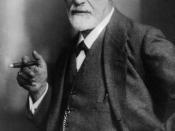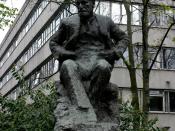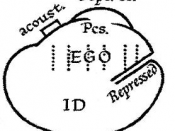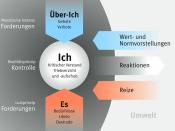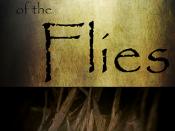The Brutality of HumanityIn his allegorical novel, Lord of The Flies, William Golding illustrates man as a morally diseased creation, and evil as an inevitable aspect of mankind. In the book, a group of schoolboys try to construct a civilisation on the island, only it breaks down in blood and terror. Golding supports Freud and his psychological theories relating to internal battles in the human mind. He also recognizes that history never rests, that it is dead, but wonÃÂt lie down. History is always in the corner, wether physically or otherwise, fuelling the fire of a conflict. Golding believed that within every human being lies, inescapable, brutal, malice. In the novel, this malice is triggered by fear of a beast, symbolising the inner evil in humans. However, evil is not the main component of a man's soul.
Sigmund Freud was a renowned neurologist who developed many theories, mostly involving the subliminal psyche.
Freud believed there is a constant subconscious battle between three impulses: the id, the ego, and the superego, or the sense of morality. One of Freud's other theories is that the superego, when overstrained or threatened, uses denial, repression and displacement as defence mechanisms. His theory is demonstrated by the following passage, after Simon is viciously murdered by both his friends and enemies, all children wether moral or savage, repress the memory and deny any wrong doing. "We got to forget this.ÃÂ We was on the outside. We never done nothing, we never seen nothing." pp. 194 While piggy is clearly sheltering his superego after such a blow as murder, he also turns a blind eye on Simon's atrocious death as suggested in the morning "I only got one eye now. You ought to know that, Ralph." p.193In the novel, Golding creates a 'physical' beast, representing the inescapable evil within man's heart. The beast is a figment of the lads' imagination, bus is just as real as war and crime. The beast is found within all humans, in child and adult alike, it represents malevolence, the darkness of man's heart, and creates fear amongst the boys. This element of fear is crucial in the novel, as is causes the boys to act barbarically and lose their innocence. Their fear reaches a level where they are willing to hunt and kill to feel safe. Simon, a truly good character, is aware that the irrational fear of the beast is causing them all to act dangerously and that the one thing they should be fearing is themselves, as they have developed the capacity to kill. However, Simon is mistaken as the beast running towards the boys, and is killed by the entire tribe. Piggy and RalphÃÂ found themselves eager to take place in this demented but partly secure society. They were glad to touch the brown backs of the fence that hemmed in the terror and made it governable. "Kill the beast! cut his throat! spill his blood! do him in!"p.188When the children beg for a sign from the grownup world, they receive a waring in the form of a fallen parachutist. This parachutist represents history, dead, but ever so active, the wind filling the parachute, and lifting the body, then resting it once again. The figure was sent as a waring to the children, yet the signal fire, which represents hope and rescue was out, and so were the twins, who misinterpreted the parachute as the beast. The irony of this situation is that, when the pilot landed on the island, history was being made as WW2 commenced, proving that the boys could not survive even if they had adult supervision, since they suffer from the incurable disease that has been genetically passed for generations- iniquity.
Man kind is a morally diseased creation. This topic was explored by William Golding, who experienced what damage society can inflict on itself during World War 2. Golding uses numerous boys with different traits to represents Freud's theories, as well as a beast to illustrate evil within individuals and society in general.
Written solely for educational purposes by Opal Sternbaum, Aus.
http://www.sparknotes.com/lit/flies/themes.htmlhttp://www.gradesaver.com/lord-of-the-flies/http://www.homework-online.com/lotf/chap09.html
